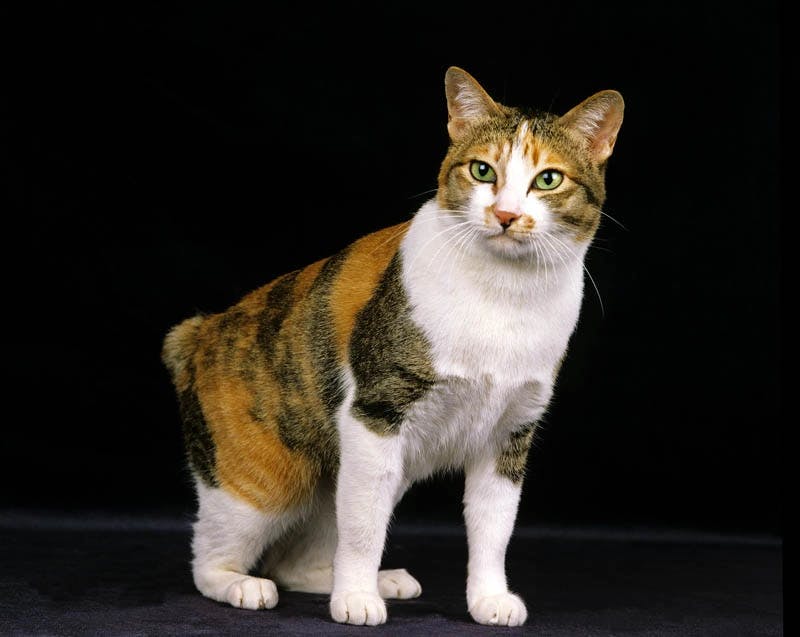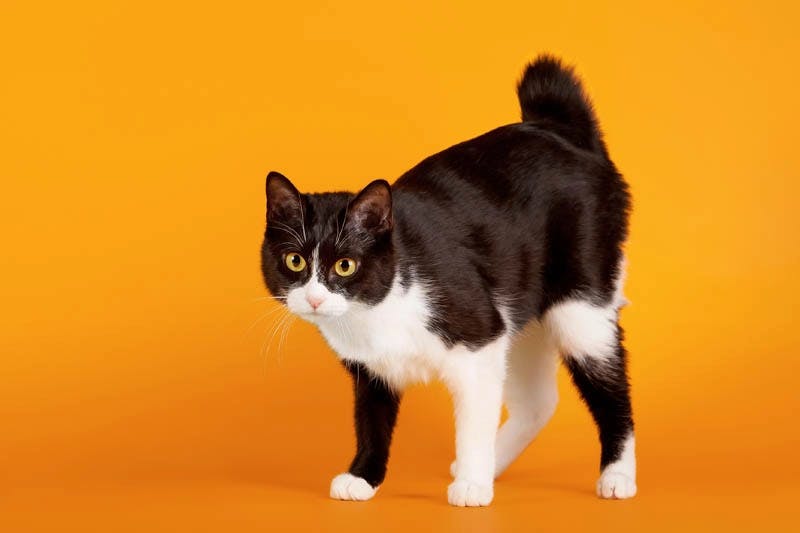Japanese Bobtail
An Extrememely Healthy Cat with a Naturally Bobbed Tail
Japanese Bobtail
Antonia Cirjak - Last Updated on December 18th, 2021
Things you Should Know about the Japanese Bobtail
Many legends and traditions surround the Japanese Bobtail. This tri-colored cat with a bobbed tail has been a symbol of good fortune in Japan for 1,000 years. It has often been described in various texts and depicted in art.
These cats are best recognized by their nubby tail. It a result of a recessive gene.
Native to Japan and Southeast Asia, these cats hold a special place in feline history.
Their replicas can often be seen as statues placed near the entrances of homes in Japan. The sculptures serve as a welcome to visitors.

Appearance Matters. What does a Japanese Bobtail look like?
Japanese Bobtails have other specific physical characteristics besides their tails. Their cheekbones are high and chiseled, and they have large eyes. Their head has a triangular shape, and the ears point upwards, which gives off an aura of alertness.
The Japanese Bobtails are medium-sized cats. With long slender bodies and powerful hind legs, they can jump very high without much effort. Their hindquarters have a deep “Z” shape, which allows them to leap to great heights.
The longest extensions of their tail bone are at no more than three inches in length.
Japanese Bobtails are different from Manx cats, which are born without a tail. This happens because of a dominant gene as well, but it’s an entirely different cat breed.
There are several other cat breeds with short hair, such as the Cymric cat or the Pixie Bob, who look quite similar to the Bobtail. However, they should not be mistaken for each other.
The Japanese Bobtail has a rabbit-like bobbed tail that is considered good luck in Asian culture. It has a soft and silky coat, with almost no undercoat. This emphasizes these cats’ elegant build because it lies flat against the body.
There are also short-haired and longhaired Japanese Bobtails.
Heterochromia in Japanese Bobtails
Sometimes, these short-tail cats can have eyes of two different colors. We call this phenomenon heterochromia. This mostly happens in Bobtails with white coats, and it gives them a unique look.
Most often, they will have one blue and one yellow iris. These variants are considered to be unique and can be very expensive.
What colors do the Japanese Bobtail cats come in?
They are well known for their tricolor calico pattern. This is known in Japan as “mi-ke,” which translates to three-fur.
There are other common color patterns, as well:
- Red
- White
- Black and white
- Chocolate
- Blue
- Lilac
- Tabby pattern
- Blue-Cream Smoke
Are Japanese Bobtail cats born without tails?
No, Japanese Bobtail Kittens are never born without tails. As their name implies, their tails are bobbed and never become full tails.
Some other cat species are known for having extremely short tails, but only one is born without a tail. This breed is the Manx, and they have a genetic mutation that makes them have no tail at all.
It's all Personal. The Japanese Bobtail Temperament
Most Japanese Bobtails are incredibly smart, active, and intelligent, and you can easily teach them to perform tricks.
Bobtails also like playing fetch or walking on a leash. They will also communicate using their voices. This means that you can often hear them use different tones and whistles.
It is easy to become a fan of the Japanese Bobtail personality. They love to play and can often be seen walking around with their favorite toy or just splashing in the water.
They also like to explore all over the house, so expect to find them snooping around. These cats have an affectionate personality, which makes them great pets.
They will occasionally settle down and take a nap, but most of the time, don’t expect them to behave as lap cats. They will jump up quickly and be on their way to the next big adventure.
Japanese Bobtails love children and will generally blend in your household without any issues. They like attention, so expect them to ask for it often.

Caring for your Japanese Bobtail
The coat of the Japanese Bobtail is easy to groom. You should brush or comb it twice per week, and you’re set. Once the spring and fall shedding seasons hit, you might need to do it more often, though.
Except for those seasonal changes, there is not that much shedding going on with these cats.
However, they are not hypoallergenic, so you should be careful with them if you have allergies. You should pay attention, especially during the seasons, when they will be shedding.
Other than that, you should trim their nails and keep their ears and teeth clean. Your veterinarian can instruct you on the best way to clean their ears and what toothpaste to get.
The Health and Happiness of your Japanese Bobtail
The Japanese Bobtail is a healthy cat that rarely has health issues. Sure, most cats can develop some health problems, such as diabetes or renal failure, but this breed does not have genetic health issues.
If you plan on getting one of these cats from a breeder, make sure that they offer a health guarantee on the kittens. Also, be careful if they mention that the kittens were isolated from the household because it could be for health reasons.
Where to Find Good Japanese Bobtail Breeders?
Known for their tails, these cats were native to Japan and Southeast Asia and are still somewhat rare in the west. You want to make sure to get one from a responsible breeder, and this is where we come in.
Take a look at our Japanese Bobtail breeders list, and find the one that suits you the most. When it comes to cats that are rare, you want to make sure you get yours from a reputable breeder.
It will help you avoid a lot of problems down the line. Their price ranges between $600 and $1,600.

Feline History. Where does the Japanese Bobtail come from?
These cats have been a part of Japanese culture for a long time now. Woodcut prints from the 1600s show tri-colored cats with bobbed tails that resemble balls of fluff.
These “Mi-Ke” cats were believed to be the heralds of good luck. Usually, they were depicted as white cats with patches of red and black.
Elizabeth Freret, a well-known breeder, imported three Japanese Bobtails from Japan to the US in 1968. The breed gained immense popularity right away, and the CFA awarded it the Championship status in 1976.
Nowadays, it is still considered a rare breed, despite several breeders in North America, Europe, and Japan.
All Japanese Bobtails registered by the Cat Fanciers’ Association can be traced back to the original imports that came from Japan.
